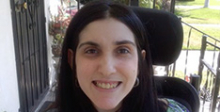As we’ve become more sensitive to the needs of persons with disabilities, one aspect of society that has remained stubbornly behind the curve are the words we use to describe another. The push for people first language is on.
Using proper terminology is empowering
Misused, outdated, or negative terminology is inappropriate and hurtful. A person with impairment should not be defined by his or her condition: He is not spastic, he has spastic Cerebral Palsy. Recognizing outdated terminology is respectful: She is not wheelchair-bound, she uses a wheelchair. Eliminating negative tone is respectful: He is not ‘special ed,’ he participates in the special education program. Eliminating disrespectful slang and words that imply victimization is appropriate: He is not a victim, unfortunate, crippled, sufferer, stricken by, retarded, spastic, or incapacitated; he simply has impairment.
As those within the medical industry and the community-based support network move towards universally accepted concepts and shared terminology, many terms will continue to be modified, changed, and more clearly define. Terminology continues to evolve.
Even though the terms impairment, disability and handicap are accepted today, they may be changed tomorrow. In fact, in 2005 the World Health Organization (WHO) recommended classifying Cerebral Palsy as an ‘activity limitation’ versus ‘impairment.’ Yet, others prefer ‘activity ability’ in order to concentrate on a person’s capability, rather than his or her limitation. Some recommend using the term ‘participation restriction’ in place of ‘handicap.’ Although recommendations are made, not all are established.
“Becoming aware of our own perceptions, stereotypes and discomforts around particular disabilities is the first step towards addressing subtle biases that could possibly be projected onto individuals with disabilities,” St. Mary’s County Commission for People with Disabilities states. “Our own beliefs and comfort level around disability has a major impact on how we view, interact, and provide service and programs.”
Taking a closer look at ‘people first’ language
We all want to see ourselves as intelligent, competent, and worthy of respect. But that’s more difficult for a child with Cerebral Palsy than it needs to be.
In the case of children with Cerebral Palsy, they may be defined in the medical setting as a child with a physical impairment, or a child with spastic quadriplegia. But, out in the community, some use outdated terminology as an identifier, such as the “handicapped child” or “disabled person.”
At school, condescending or immature peers may use crude terminology, like “retard,” “spaz,” or “crippled” in hurtful ways. The media may inappropriately call the child “a victim of” or “afflicted with” Cerebral Palsy.
To those of us that don’t have physical or cognitive challenges, these words may not mean much; we may believe that people with special needs should just brush off negative comments. Worse, some people may believe a request to use kinder language may feel like political correctness has run amok or feel there is an invasion of the first amendment rights pertaining to the use of free speech. Some will say that words only hurt if you let them.
Luckily, most people who say or write “disabled person” mean no harm. In most cases, it just doesn’t occur to many of us that such a statement is a label. It amounts to labeling a person by their condition without taking into account his or her abilities, feelings, or aspirations. That’s generally not what most of us intend to do.
The evolution of “people first language” is the answer to this conundrum. A form of linguistic prescriptivism, people first language always acknowledges that a person with disabilities is a person, first and foremost. It advocates that a person should not be defined by a medical condition unless it is relevant to the conversation, at hand. For example, we wouldn’t find it relevant to say “the blue-eyed boy ate candy” so why would we need to say “the disabled girl was wearing a red shirt today?” Instead, “the boy ate candy” and “the girl wore a red shirt” would suffice.
Disability advocates hope people first language becomes a foundation of disability etiquette that is widely used.
Language progression
In society, language progresses to meet societal demands.
Once upon a time, those with physical disabilities were referred to as “handicapped.” Today, you would be hard-pressed to use the term in conversation because it has become more fully defined throughout the years. For example, a handicap is apparent only when the barrier or obstacle exists. For a person that uses a wheelchair for mobility, stairs and narrow hallways may present a handicap. Ramps, elevators, and alternate hallways remove the handicap.
Currently, the World Health Organization (WHO) defines two types of handicaps:
- Activity limitations – These are difficulties an individual may have in executing a task or action
- Participation restrictions – These are restrictions imposed upon an individual’s involvement in an activity.
With the onset of inclusion, accessibility, and universal design standards, much is being done to identify, then remove, barriers and obstacles for those with impairment, essentially, eliminating handicaps altogether.
Changes in the use of terminology, however, are slow to take hold. Even though the term “handicapped” has long been replaced, to this day, you can go to a local shopping center or grocery store and see a “handicapped parking space,” a “handicapped exit,” or a “handicapped accessible bathroom.”
Other words, like “retarded,” are technically clinical terms that morphed into insults. Today, they are more recognized as a derogatory term than a harmless medical descriptor. People first advocates will propose that since these words are not often used in a medical setting, there should be no reason to use them outside the physician’s office.
They also acknowledge that in English class we are taught syntax rules that dictate an adjective-before-noun construct, for example “disabled person.” Yet, they purport the compassionate construct is to refer to “a person with a disability.” Even though the people first construct goes against the grain of what is taught, they emphasize that in this case it is right thing to do.
Words hurt
Most of us would not want to have our challenges front and center as a reminder in all that we do. Those of us that are short in stature would not want to be called “the short person” eating breakfast. Others of us that have trouble grasping mathematical information would not want to be referred to as “mathematically deficient” individual getting their hair washed at the salon. In both cases, the descriptor used has nothing to do with the circumstances. These are odd examples to contemplate, for sure.
If you think about it, though, children with disabilities deal with similar labels all of the time. In school, they may have to attend classes separate from other students. This already implies that they’re somehow different from their peers.
Many board buses that are often smaller than the standard bus length and are equipped to support special needs, able to accommodate safety requirements, and made accessible with ramps and lifts. Unfortunately, the buses have been labeled the “the short bus” which has somewhat morphed into derogatory labeling. It insinuates that someone that rides “the short bus” is someone that is lacking intelligence yet intelligence has nothing to do with why they are required to ride the bus.
Those with conditions that may require additional assistance, help, or technology are referred to as having special needs. The term “special needs” generally refers to the actual need a child has, particularly in situations where accessibility is required, such as access to education, transportation, work settings, government programs, public venues, and housing, to name a few.
Likewise, the term “disability” was developed to define an impairment that substantially limits a person’s ability to perform life activities within a range comparable to someone the same age and under the same circumstances. It was intended to include impairments that limit mobility, hearing, sight, learning, and communication.
The term “disability” is primarily used in efforts to qualify a person fairly for government benefits, access to healthcare, special education programs, worker’s compensation, workplace accommodations, travel accommodations, or health insurance. The term, however, wasn’t meant to be a harmful label to segregate a person from respect or worthiness as a human being.
Being referred to as a “special needs student” or “disabled child” is likely to make a young person feel he or she has challenges that cannot be overcome. It fosters a sense of hopelessness. It implies that a child is broken; that he or she is in need of repair and is lacking in some way. Instead, being referred to as a child with special needs or a child with a disability is referencing their condition and not labeling their esteem.
People first philosophy is meant to empower
Today, most educators, policy makers, therapists and community leaders have made an effort to integrate people first language into their work. Many others that come into contact with your child likely have not, however.
Even though parents cannot control what other people say, or how they act there are ways that parents can make people first language a priority in their child’s life. Parents should interact with those that spend time with their child – family, friends, caregiver, daycare provider, and teacher – to educate them on their child’s condition. They should stress that misused, outdated, or negative terminology is hurtful to the child.
Parents will want to surround their child with a positive environment in which to develop self-esteem and well-being. As influencers in a child’s life, their comfort level and how they view, interact, intercede and perceive the child influences how they and others will also treat the child. These individuals will likely want the parent and the child to thrive, and will be receptive to people first point of view.
Here are some helpful tips towards a people first philosophy:
- Don’t define the child by his or her impairment. He is not spastic, he has spastic Cerebral Palsy. She is not a disabled child, she is a child with a disability.
- Don’t identify the child by the impairment or disability, unless it is relevant. Example: “The individual using the wheelchair…” is only deemed appropriate when the use of the wheelchair is relevant to the conversation.
- Don’t use slang to label a person. He is not a “cripple,” “retarded,” “disabled,” “impaired,” “spastic,” or “special ed.” He is simply a child with special needs.
- Keep abreast of and use updated terminology. Example: She is not “wheelchair-bound,” “physically-handicapped,” “differently-abled,” or “physically challenged.” Instead, “She uses a wheelchair,” “she has a disability,” and “she has a physical impairment.”
- Eliminate negative tone as it is hurtful. For example, he is not “special ed,” he participates in the special education program.
- Eliminate disrespectful slang and words that imply victimization. For example, he is not a victim, unfortunate, crippled, sufferer, stricken, or invalid. He simply has impairment.
- Become familiar with the level of impairment. Example:
- A person with total hearing loss is considered a person who is without hearing.
- A person with partial hearing loss is referred to as a person with hearing impairment.
- A person with total sight loss is not referred to as “a blind person,” but as “a person who is blind.”
- A person with a varying degree of sight — a person who can see but is not considered legally blind, for example — is a person with vision impairment.
- A person who displays trouble speaking, uses voice prosthesis, or appears to stutter is “a person with speech impairment.”
Also, “normal” is a word that, depending on its context, should not be used. It’s okay to say “It’s normal to feel down once in a while.” It’s not acceptable to say “John uses a walker because his legs aren’t normal.” A better way to express the sentiment would be “John often uses a walker to get to and from school.”
Words are the mode by which we use to inspire others by verbalizing thoughts and feelings. The things we say to each other are as important in our relationships as the deeds we do.
By the same token, the words we hear – especially about ourselves – form how we see our lives.
Children, who are in the process of building their self-images in a world that too often makes developing self-acceptance a challenge, are information sponges that absorb not only words, but the spirit in which the words are spoken.
To the largest extent possible, you want the words associated with your child to be a positive reflection of whom he or she is – not how he or she moves or conducts tasks. You want those words to stress what your child has in common with other children. Implementing people first language is an excellent first step.
Disability Terminology
DOs:
Do Use Terminology Properly
Become aware of proper meaning behind terms. Improper use leads to hurt feelings, offended individuals, and disrespectful use of language.
Do Respect the Person, First
Referring to an individual by their impairment is no longer acceptable. Acceptable terminology accentuates the person first, then mentions their impairment, only if pertinent. Labeling an individual is inappropriate. Describing an individual is appropriate. Do this by placing emphasis on the person, not their condition. It is proper to say ‘person with disability’ as opposed to ‘disabled person.’ It is proper to say ‘person with epilepsy’ versus ‘the epileptic.’ It is appropriate to state ‘the boy with quadriplegia’ versus ‘the quadriplegic.’
Do Get to Know the Level of Impairment
A person with total hearing loss is considered ‘a person who is without hearing,’ but is not considered a ‘deaf person.’ Likewise, a person with partial hearing loss is referred to as ‘a person with hearing impairment.’ A person with total sight loss is considered ‘a person who is blind,’ but is not considered a ‘blind person.’ A person with a varying degree of sight — a person who can see but is not considered legally blind, for example — is ‘a person with vision impairment.’ A person who displays trouble speaking, uses voice prosthesis, or appears to stutter is ‘a person with speech impairment.’
DON’Ts:
Do Use Terminology Properly
Become aware of proper meaning behind terms. Improper use leads to hurt feelings, offended individuals, and disrespectful use of language.
Do Respect the Person, First
Terms like physically challenged, differently-abled, physically-handicapped, and wheelchair-bound are outdated. The current trend is to limit the use of labeling terms with negative connotations. Descriptive terms without judgment are accepted. For instance, ‘the individual using the wheelchair’
Don’t Refer to a Person with Impairment in a Negative Way
Negativity is disempowering. The impairment is a condition, not a result of violence. A person should not be given a label that insinuates inappropriate treatment. For instance, do not use victim, sufferer, stricken by, deformed, incapacitated, unfortunate, invalid, or affl icted with. For instance, ‘John mahave cancer,’ but John is never ‘a cancer victim.’ total sight loss is considered ‘a person who is blind,’ but is not considered a ‘blind person.’ A person with a varying degree of sight — a person who can see but is not considered legally blind, for example — is ‘a person with vision impairment.’ A person who displays trouble speaking, uses voice prosthesis, or appears to stutter is ‘a person with speech impairment.’











